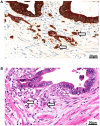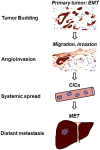Tumor budding in upper gastrointestinal carcinomas
- PMID: 25177546
- PMCID: PMC4132482
- DOI: 10.3389/fonc.2014.00216
Tumor budding in upper gastrointestinal carcinomas
Abstract
The basis of personalized medicine in oncology is the prediction of an individual's risk of relapse and death from disease. The presence of tumor budding (TB) at the tumor-host interface of gastrointestinal cancers has been recognized as a hallmark of unfavorable disease biology. TB is defined as the presence of dedifferentiated cells or small clusters of up to five cells at the tumor invasive front and can be observed in aggressive carcinomas of the esophagus, stomach, pancreas, ampulla, colon, and rectum. Presence of TB reproducibly correlates with advanced tumor stage, frequent lymphovascular invasion, nodal, and distant metastasis. The UICC has officially recognized TB as additional independent prognostic factor in cancers of the colon and rectum. Recent studies have also characterized TB as a promising prognostic indicator for clinical management of esophageal squamous cell carcinoma, adenocarcinoma of the gastro-esophageal junction, and gastric adenocarcinoma. However, several important issues have to be addressed for application in daily diagnostic practice: (1) validation of prognostic scoring systems for TB in large, multi-center studies, (2) consensus on the optimal assessment method, and (3) inter-observer reproducibility. This review provides a comprehensive analysis of TB in cancers of the upper gastrointestinal tract including critical appraisal of perspectives for further study.
Keywords: epithelial–mesenchymal transition; esophageal cancer; gastric cancer; gastrointestinal cancer; prognostic factor; tumor budding; tumor microenvironment.
Figures



Similar articles
-
Tumor budding as a standardized parameter in gastrointestinal carcinomas: more than just the colon.Mod Pathol. 2018 Jun;31(6):862-872. doi: 10.1038/s41379-018-0028-4. Epub 2018 Feb 6. Mod Pathol. 2018. PMID: 29403085 Review.
-
Prognostic value of tumor budding in gallbladder cancer: application of the International Tumor Budding Consensus Conference scoring system.Virchows Arch. 2021 Jun;478(6):1071-1078. doi: 10.1007/s00428-020-03012-2. Epub 2021 Jan 4. Virchows Arch. 2021. PMID: 33398430
-
Prognostic significance of tumor budding in gastrointestinal tumors.Expert Rev Anticancer Ther. 2011 Oct;11(10):1521-33. doi: 10.1586/era.11.156. Expert Rev Anticancer Ther. 2011. PMID: 21999126 Review.
-
Tumor budding as a risk factor for nodal metastasis in pT1 colorectal cancers: a meta-analysis.Hum Pathol. 2017 Jul;65:62-70. doi: 10.1016/j.humpath.2017.04.013. Epub 2017 Apr 22. Hum Pathol. 2017. PMID: 28438617 Review.
-
Tumor budding in upper urinary tract urothelial carcinoma: a putative prognostic factor for extraurothelial recurrence and overall survival.Virchows Arch. 2021 Jul;479(1):45-55. doi: 10.1007/s00428-020-02989-0. Epub 2021 Jan 6. Virchows Arch. 2021. PMID: 33404852
Cited by
-
Exploring the Usefulness of Tumor Budding as a Histopathological Marker Compared to Tumor-Node-Metastasis (TNM) Staging in Breast Cancer.Cureus. 2024 Sep 27;16(9):e70315. doi: 10.7759/cureus.70315. eCollection 2024 Sep. Cureus. 2024. PMID: 39469410 Free PMC article.
-
Clinicopathologic correlations of superficial esophageal adenocarcinoma in endoscopic submucosal dissection specimens.Diagn Pathol. 2021 Nov 27;16(1):111. doi: 10.1186/s13000-021-01169-1. Diagn Pathol. 2021. PMID: 34838082 Free PMC article.
-
Long-Term Postsurgical Outcomes of Neoadjuvant Chemoradiation (CROSS) Versus Chemotherapy (FLOT) for Multimodal Treatment of Adenocarcinoma of the Esophagus and the Esophagogastric Junction.Ann Surg Oncol. 2023 Nov;30(12):7422-7433. doi: 10.1245/s10434-023-13643-9. Epub 2023 May 21. Ann Surg Oncol. 2023. PMID: 37210683 Free PMC article.
-
Tumor Budding: The Name is EMT. Partial EMT.J Clin Med. 2016 Apr 29;5(5):51. doi: 10.3390/jcm5050051. J Clin Med. 2016. PMID: 27136592 Free PMC article. Review.
-
High-grade intratumoral tumor budding is a predictor for lymphovascular invasion and adverse outcome in stage II colorectal cancer.Int J Colorectal Dis. 2020 Feb;35(2):259-268. doi: 10.1007/s00384-019-03478-w. Epub 2019 Dec 14. Int J Colorectal Dis. 2020. PMID: 31838579
References
-
- Bosman FT, World Health Organization, and International Agency for Research on Cancer WHO Classification of Tumours of the Digestive System. Lyon: International Agency for Research on Cancer; (2010).
Publication types
LinkOut - more resources
Full Text Sources
Other Literature Sources

